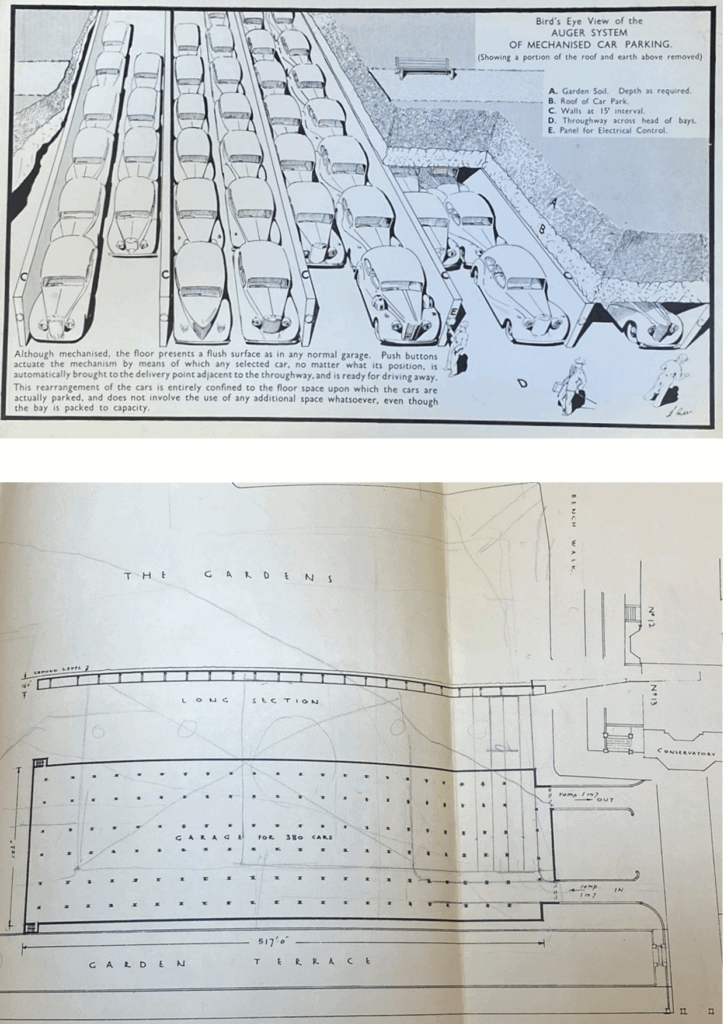Contents
“Don’t adventures ever have an end? I suppose not. Someone else always has to carry on the story.”
Graduate Trainee Librarian Leaves
Visit to the Law Society Library and Archives
The Warburg Institute Visit
The Jigsaw Murders
New Acquisitions
World No-Tobacco Day
After 1925: Reflecting on 100 years of Property Legislation
Gems from the Archives
“Don’t adventures ever have an end? I suppose not. Someone else always has to carry on the story.”
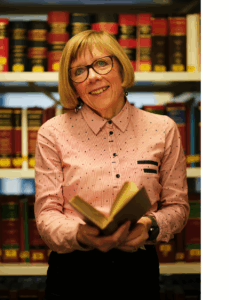 As a Lord of the Rings fan, I felt that this observation from Bilbo Baggins would be an apt way to begin my final article for the Inner Temple Library Newsletter.
As a Lord of the Rings fan, I felt that this observation from Bilbo Baggins would be an apt way to begin my final article for the Inner Temple Library Newsletter.
After 37 years as a law librarian my adventure is about to end in retirement, and it has been a fantastic experience that I can reflect back on with much pleasure.
My adventure has seen me work in a variety of libraries – 2 Inns of Court Libraries, the House of Lords and a couple of law firms. Every job has been rewarding and satisfying. Being a law librarian was where I was meant to be.
It all began in 1988 when I went for an interview at Lincoln’s Inn Library. I was very fortunate to get the job as Senior Library Assistant. This was my first job as a qualified librarian, and I had no idea in 1988 what a fantastic working life I would have.
Things were very different in the late 1980s. I don’t just mean fashion and music, but in how law libraries were organised and how we did our work.
There were no computers, no internet and no access to databases. Instead, we did everything by hand and relied on our knowledge and skills as librarians.
Finding books could not be done using an online catalogue – there wasn’t one.
At Lincoln’s there were large ledgers arranged by author and subject.
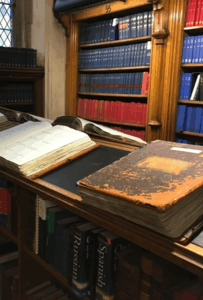
At the Inner Temple we had card catalogues…
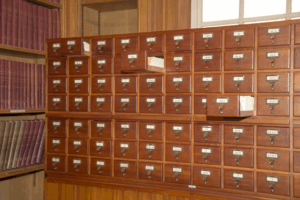
Back in the late 1980s legal research also had to be done without recourse to online resources.
For example, a member of the team would annotate (‘note up’) the volumes of The Law Reports to indicate if a case had been subsequently referred to. We don’t do this anymore as Westlaw and Lexis+ case histories do it for us.
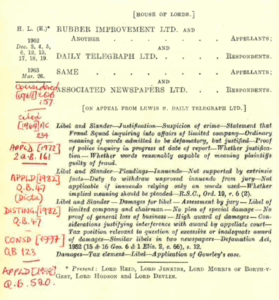
When the Inns of Court Libraries took out subscriptions to Westlaw and Lexis, some things did get easier, but over the years it has become clear to me that as good as the databases are we still have to use hard copy resources for many of the enquiries that we receive in the Library. It is simply not the case that everything is online – we would not be in our basements retrieving material every day if this were the case.
For me personally using databases and hard copy materials makes for a varied and interesting job. It means I use different skills when using the different media – something that keeps me on my toes when the databases decide to change their platforms, as they have done fairly frequently.
Over the years I have seen changes not only in the way we undertake research but also in the kind of services we offer.
One of the biggest changes is in the training we now offer to our various users. Library staff take part in the Inn’s series of Qualifying Sessions, we offer training to new pupils, and we collaborate with the other Inns in supporting the ICCA course with lectures and feedback sessions.
Public speaking was not something I had any experience of many years ago, but I have enjoyed developing this skill and have found the sessions I have been part of very satisfying.
I am retiring at an interesting time when AI is becoming more and more part of our working lives.
I have looked at some of the AI products being developed for legal research and part of me is sad not to be working in the Library at this important time. But as I reflect back I do not see AI as a threat to the role of law librarian. As good as some of these products may eventually become, it will still require trained specialists to help and instruct users on how to make best use of the products. After all, relevant materials will only be found if the user inputs the right data – this is what we help with every day.
And as I said above, no database will ever match the content that we have in this library.
I am very lucky to have had a long and rewarding career as a law librarian. I have worked in a variety of institutions, learnt so many new skills and as part of the Inner Temple Library Team I have helped to keep the Library relevant and an important part of the Inn.
My adventure is ending but I have no doubt that the Library will flourish and continue to expand its services and move forward, keeping pace with technology and embracing all that AI has to offer.
Graduate Trainee Librarian Leaves
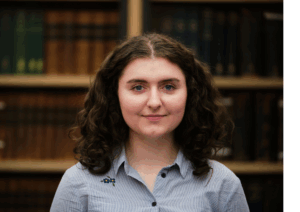 My three years at the Inner Temple Library were a fantastic, formative experience, and one I will never forget. I joined the Inn in 2022 as the Graduate Trainee Librarian, and received a world-class education in legal librarianship – including in-depth training in all aspects of legal research, visits to other libraries and institutions like the House of Lords, and fundamental library skills such as cataloguing and collection management. I was also fortunate enough to deploy other skills from my previous experience as a book historian, putting together exhibitions of early modern books for postgraduate students at KCL and transcribing a document relating to legal proceedings arising from a plot to assassinate Queen Elizabeth I for publication in an academic monograph. The Library was then kind enough to sponsor my place to complete the MA in Library and Information Studies at UCL, an essential qualification required to pursue more advanced roles in the library sector. I’m now nearing the end of the course, and without this sponsorship, I would not have been able to secure my new position as Assistant Librarian (Collections) at The Law Society Library. At The Law Society, I will be utilising the legal research and library skills I learnt at the Inn to undertake legal research on behalf of solicitors, organise acquisitions and the space in the library and beyond, catalogue library resources, and more. I am so grateful for the skills, knowledge and friendships I made at the Inner Temple Library, and I already miss it dearly.
My three years at the Inner Temple Library were a fantastic, formative experience, and one I will never forget. I joined the Inn in 2022 as the Graduate Trainee Librarian, and received a world-class education in legal librarianship – including in-depth training in all aspects of legal research, visits to other libraries and institutions like the House of Lords, and fundamental library skills such as cataloguing and collection management. I was also fortunate enough to deploy other skills from my previous experience as a book historian, putting together exhibitions of early modern books for postgraduate students at KCL and transcribing a document relating to legal proceedings arising from a plot to assassinate Queen Elizabeth I for publication in an academic monograph. The Library was then kind enough to sponsor my place to complete the MA in Library and Information Studies at UCL, an essential qualification required to pursue more advanced roles in the library sector. I’m now nearing the end of the course, and without this sponsorship, I would not have been able to secure my new position as Assistant Librarian (Collections) at The Law Society Library. At The Law Society, I will be utilising the legal research and library skills I learnt at the Inn to undertake legal research on behalf of solicitors, organise acquisitions and the space in the library and beyond, catalogue library resources, and more. I am so grateful for the skills, knowledge and friendships I made at the Inner Temple Library, and I already miss it dearly.
Visit to the Law Society Library and Archives
The visit started in a waiting room with portraits of Carrie Morrison and other pioneering women solicitors. We were then shown up to the library. The building is Grade II* listed; our attention was drawn to the faux-marble scagliola pillars. There is also a very impressive fireplace (not in use) at the far end of the library.
The library currently has the first in a series of exhibitions celebrating the Law Society’s 200th anniversary this year. The Society was founded to improve the image of attorneys. The profession had long been satirised, for example as “Pettifoggers and Vipers”. By the early 19th century, the profession had a reputation of consisting of unscrupulous and often unqualified practitioners who had a regrettable tendency to abscond with their clients’ funds.
The exhibition included a 1729 list of attorneys and solicitors, and examples of rolls of solicitors – literally rolls of parchment with the solicitors’ signatures. Some of these are currently being cleaned, and there is a conservator’s workstation in the library so that this process can be observed. Other items on display included notices of meetings at the Devil Tavern which stood on Fleet Street on the site now occupied by Child & Co’s bank, and Powell’s 1623 Attourneys Academy which included, in a single volume, everything someone would need to know to qualify as an attorney (the Inner Temple Library holds the 1630 edition). There was also a facsimile of an illustration from the play Ignoramus; while the protagonist of the play was actually a barrister, the illustration is one of the earliest images of an attorney, as can be seen from the books on a shelf in the background.
The next exhibition was scheduled to start in April, and covers public funding and legal aid.
As well as the library’s legal collection we saw the collection of law lists and registers of articled clerks. There was also a solicitor’s document box, containing microfilmed records (now digitised) of deceased solicitors and a remarkable burglar alarm. Probably dating from the early 1960s, this featured a small record player, and when triggered phoned the local police station and played a message saying that there were intruders in the building.
In the archives we saw a set of manuscript genealogies of legal families, and a collection of papers and artefacts relating to the society’s 100th anniversary. There was also a top hat which had been found in a basement store room, formerly used by members, in its original case from the outfitters, but with a replaced band with more than one set of initials indicating a change of ownership.
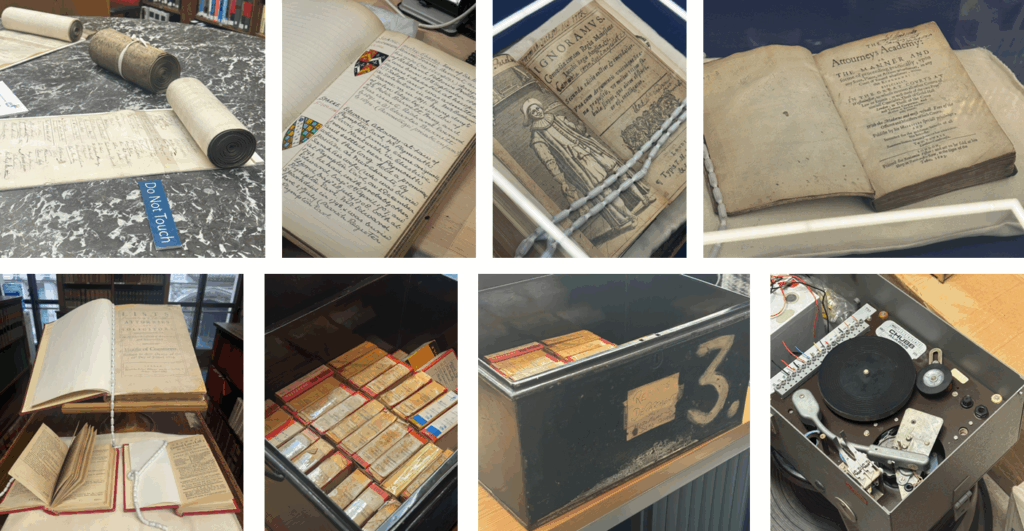
The Warburg Institute Visit
On 5 February, five members of staff were given a tour of the Warburg Institute Library and Photographic collection. The Kulturwissenschaftliche Bibliothek Warburg (as it was originally called) was founded in Hamburg by the art historian Aby Warburg (1866-1929), the eldest son of a prominent banking family. He had, as an adolescent, struck a deal with one of his brothers that he (Aby) would give up his right to take over the family firm on condition that the brother would buy him whatever books he needed. This proved an expensive bargain for the brother: by the time the Library moved to London, a few years after Warburg’s death, it contained around 60,000 volumes. Today the Institute is part of the School of Advanced Study of the University of London, and the Library (with holdings approaching 400,000 volumes) is the largest collection in the world focused on the afterlife of antiquity and the survival and transmission of culture, with a particular emphasis on medieval and renaissance studies. Unusually for a research library containing a high proportion of early printed books and other items of great rarity, almost all the books are on open access. Browsing is very much encouraged. An observation by Warburg’s assistant, Gertrud Bing, is instructive in this regard:
“The reader … looking on the shelves for one book, is attracted by the kindred ones next to it, glances at the sections above and below, and finds himself involved in a new trend of thought which may lend additional interest to the one he was pursuing.”
Like its predecessor in Hamburg, the Library is arranged over four floors, each devoted to a category or theme, namely Word (mainly ancient and post-medieval literature); Image (art history, archaeology and early cultures); Orientation (philosophy, religious studies and history of science); and Action (history, social history, history of festivals, theatre and technology).
This was a fascinating, instructive and entertaining visit. Thanks are due to Clare Lappin, Deputy Librarian, and Paul Taylor, Curator of the Photographic collection, for making us so welcome.
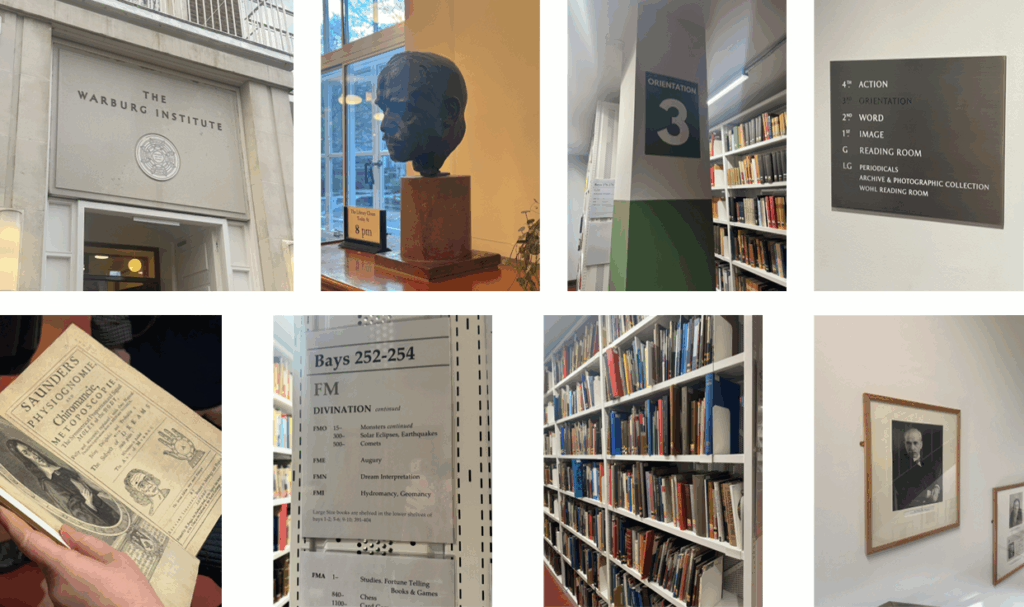
The Jigsaw Murders
In September 1935 a tourist visiting Moffat, Dumfriesshire, noticed a package with a human arm protruding from it under a bridge. This led to the discovery of two bodies which had been dissected and mutilated, apparently in an attempt to prevent identification. The case, which became known as the Jigsaw Murders, is notable for the innovative use of forensic science techniques to identify the victims, Isabella Ruxton and Mary Jane Rogerson, and the locations of the murders and subsequent dismemberment. Dr Buck Ruxton, the husband of Isabella, was found guilty of the murders of both women.
The bodies were examined by Professors John Glaister Jr., James Couper Brash, and Sydney Smith at Edinburgh University. In 2024 the University announced that it had discovered that it was still in possession of some of the remains in its Sydney Smith Collection, and appealed for information that might enable it to trace any of the women’s relatives so that the remains could, if they wished, be returned to them for burial.
The case generated a good deal of public and scientific interest, and was mentioned by Agatha Christie in her 1940 novel, One, Two, Buckle My Shoe. After discussing the case with Glaister, Earle Stanley Gardner dedicated a Perry Mason novel, The Case of the Horrified Heirs, to him.*
The Library’s Trials collection includes two accounts of the trial, and in the Medico-Legal collection there is a short contemporary account in the Medico-Legal and Criminological Review, Vol. 4, p. 144. The Library’s Criminology collection includes Glaister and Brash’s 1937 book, Medico-Legal Aspects of the Ruxton Case.
There was a BBC news story about the case earlier this year.
*The Library does not hold either of these works.
New Acquisitions
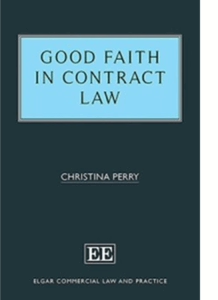 Christina Perry, in Good Faith in Contract Law (Edward Elgar) combines detailed legal analysis with commercial guidance, in her examination of the law relating to good faith in commercial contracts and the practical, procedural, and legal issues that arise in respect of this often contentious area. The author evaluates express and implied good faith obligations in common and civil law contracts, as well as in commercial, employment, insurance, partnership, and agency agreements.
Christina Perry, in Good Faith in Contract Law (Edward Elgar) combines detailed legal analysis with commercial guidance, in her examination of the law relating to good faith in commercial contracts and the practical, procedural, and legal issues that arise in respect of this often contentious area. The author evaluates express and implied good faith obligations in common and civil law contracts, as well as in commercial, employment, insurance, partnership, and agency agreements.
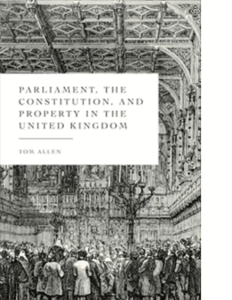 In theory, there is nothing to stop Parliament from passing laws to confiscate property. Nevertheless, MPs often argue that a proposed law would be unconstitutional. What does this mean in a system without a written constitution? What counts as a sound argument about constitutional rights? And what influence do constitutional arguments have on the legislative process? Tom Allen’s Parliament, the Constitution and Property in the United Kingdom (Hart) takes a close look at these questions. It reviews legislation and debates from the Middle Ages through to more recent legislation, and covers a wide range of topics, such as land reform, nationalisation, taxation, regulatory laws and retrospectivity. Allen also refers to the most recent debates and considers the relevance of constitutional thinking to the election manifestos of the main political parties.
In theory, there is nothing to stop Parliament from passing laws to confiscate property. Nevertheless, MPs often argue that a proposed law would be unconstitutional. What does this mean in a system without a written constitution? What counts as a sound argument about constitutional rights? And what influence do constitutional arguments have on the legislative process? Tom Allen’s Parliament, the Constitution and Property in the United Kingdom (Hart) takes a close look at these questions. It reviews legislation and debates from the Middle Ages through to more recent legislation, and covers a wide range of topics, such as land reform, nationalisation, taxation, regulatory laws and retrospectivity. Allen also refers to the most recent debates and considers the relevance of constitutional thinking to the election manifestos of the main political parties.
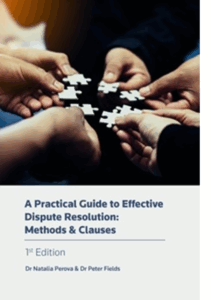 The aim of A Practical Guide to Effective Dispute Resolution: Methods and Clauses by Natalia Perova and Peter Fields (Sweet & Maxwell) is to provide practical insights into how to mitigate the economic impact of disputes and the hidden costs of litigation. This includes understanding why disputes escalate and how traditional litigation can polarise a dispute and end up destroying business relationships. The focus is on the active consideration of alternative methods that can save time, reduce costs, and preserve partnerships. The emphasis is on effective, rather than alternative, dispute resolution.
The aim of A Practical Guide to Effective Dispute Resolution: Methods and Clauses by Natalia Perova and Peter Fields (Sweet & Maxwell) is to provide practical insights into how to mitigate the economic impact of disputes and the hidden costs of litigation. This includes understanding why disputes escalate and how traditional litigation can polarise a dispute and end up destroying business relationships. The focus is on the active consideration of alternative methods that can save time, reduce costs, and preserve partnerships. The emphasis is on effective, rather than alternative, dispute resolution.
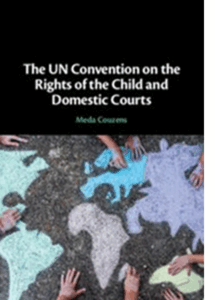 The UN Convention on the Rights of the Child and Domestic Courts: a Comparative International Law Perspective (Cambridge) by Meda Couzens important contribution to children’s rights scholarship brings fresh eyes to the complicated relationship between domestic law and international law in the practice of domestic courts. Through a critical assessment of the judicial application of the Convention on the Rights of the Child in four jurisdictions (Australia, France, South Africa and the United Kingdom), the book demonstrates that the traditional rules of reception remain an essential starting point in understanding how national courts apply the Convention but are unable to explain all forms of judicial engagement therewith.
The UN Convention on the Rights of the Child and Domestic Courts: a Comparative International Law Perspective (Cambridge) by Meda Couzens important contribution to children’s rights scholarship brings fresh eyes to the complicated relationship between domestic law and international law in the practice of domestic courts. Through a critical assessment of the judicial application of the Convention on the Rights of the Child in four jurisdictions (Australia, France, South Africa and the United Kingdom), the book demonstrates that the traditional rules of reception remain an essential starting point in understanding how national courts apply the Convention but are unable to explain all forms of judicial engagement therewith.
Thanks are due to the following, who have kindly presented books to the Library in recent months: Master Julia Dias for Carver on Charterparties, 3rd edition; Professor James Lee (Academic Bencher) for Hanbury and Martin’s Modern Equity, 23rd edition; Professor Yvonne McDermott Rees (Academic Bencher) for Proving International Crimes; Professor Adrian Keane for The Modern Law of Evidence, 15th edition; Roderick I’Anson Banks for Lindley and Banks on Partnership, 2024 supplement; Terez Fitzherbert for Sir Antony Fitzherbert and La Graunde Abridgement by F.L. Boersma; Barry Denyer-Green for Compulsory Purchase and Compensation, 12th edition; Catherine Tuitt MBE for You Are Not Bossy, You Are Your Own Boss: Management and Leadership Strategies; Daniel Sokol for From Error to Ethics; Chan & Associates for Freeing the Market: A Handbook on Competition Law in Malaysia, 2nd edition; Master John Kimbell for Admiralty Jurisdiction and Practice, 6th edition; and Judith Ratcliffe for Hide or Speak?, which concerns the Data Protection and Digital Information Bill.
A list of new law titles and editions received from January to April is available on our website.
World No-Tobacco Day
A Foolish Song upon Tobacco, by J.F.
Petyt MS 538.43 ff. 284-303, early 17th Century

For the World Health Organization’s No Tobacco Day, we thought we might share something from our manuscript collection. Petyt MS 538.43 contains eighteen items of various sizes covering diverse topics. One group of items (ff. 284-303), all written in the same neat italic hand, are presumed to be a copy of psalms and verses originally sent to Lucy Russell, Countess of Bedford (1580-1627), from Sir John Harington (1561-1612) in December 1600. To accompany the psalms, he writes that he has included “shallowe meditations of myne owne not to conioyne with them; for that were to piece sattin with sack-cloth”. If the sack-cloth represents his own poems and epigrams, then the ‘sattin’ would be that for which this manuscript is most celebrated: Mary Sidney, Countess of Pembroke’s verse translations, including her Psalms and an English version of Petrarch’s ‘Triumph of Death’ (c.1600).
Unusually, we are leaving Sidney’s translations to one side and focussing on another item in this manuscript group. It is listed in the Royal Commission on Historical Manuscripts report of 1888 as “A foolish song upon Tobacco [against it]”, the author unknown but for the initials J.F. Despite a light-hearted tone
“Will you drink a pipe of Tobacco? bis
‘Tis good for the head, and naught for the braine.
‘Twill make a man sick, and sober again…
…T’will make a man loose, and prove him a goose”
by its conclusion there can be no doubt that this is indeed a poem against tobacco:
“He was a right Divell, that found out this evell,
To bewitch so our mynde, and plague all mankind
Then leave theis pipes of Tobacco. bis”
Knowledge about the harms of tobacco is clearly not new. A less frivolous contemporary attack on tobacco consumption can be found in A Counterblast to Tobacco published by James I in 1604. Describing tobacco as “hatefull to the Nose, harmefull to the braine, dangerous to the Lungs, and in the blacke stinking fume thereof, neerest resembling the horrible Stigian smoke of the pit that is bottomelesse.” Despite sharing the same message, J.F.’s ‘foolish song’ may not have had the same lasting impact as James I’s publication. The latter was recently quoted in the Public Bill Committee (Fourth Sitting) Debate on the Tobacco and Vapes Bill in January 2025.
Although there are other intriguing items in this miscellany, including a poem on elephants, The Melancholy Knight’s Complaint in the Wood by Dr Edes, and the bawdy Choise of Valentines by Thomas Nashe (1592/3?), none carries the seventeenth-century equivalent of a cigarette packet health warning :
“T’will marre ones breath, and bring him to death”.
After 1925: Reflecting on 100 years of Property Legislation
On 10 April a fascinating seminar took place at the Inner Temple, organised by Academic Bencher Professor Judith Bourne, Dean of CILEX Law School.
The previous day marked the centenary of 100 years of property legislation from the passage of the Law of Property Act of 1925, described by speaker Dr David Sheldon of the University of Bristol as “a blockbuster event in the world of property”. Reform had been attempted before, but the need for the reform of English land law had been recognised for centuries before reform was attempted. As Professor Philipp Elliot-Wright remarked, “no less a person than Oliver Cromwell described land law in England as ‘a tortuous and ungodly jumble.’” The 1925 reforms were driven by a multitude of socio-economic factors, the background to which was explained by Professor Elliot-Wright.
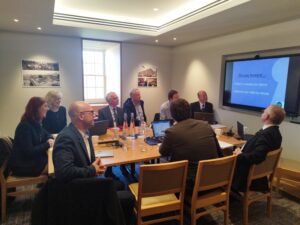 The seminar of experts in the world of property examined the background and antecedents to the reform, tracing it through to its application in modern property transfers and the growth of a specialist national property law tribunal, discussed by two of the full-time judges, Principal Judge Michael Michell and Judge Ewan Paton, who revealed the ‘matters’ with which the tribunal deals. Dr Matthew Stubbins, Head of Law at Canterbury Christ Church University, reflected on s. 60(3) of the LPA 1925 and posed two questions that remain unanswered a century after the LPA’s enactment: was it a ‘reforming’ device or merely a ‘word-saving’ provision, and what is the correct interpretation of s. 60(3) and the position of gratuitous transfers of land?
The seminar of experts in the world of property examined the background and antecedents to the reform, tracing it through to its application in modern property transfers and the growth of a specialist national property law tribunal, discussed by two of the full-time judges, Principal Judge Michael Michell and Judge Ewan Paton, who revealed the ‘matters’ with which the tribunal deals. Dr Matthew Stubbins, Head of Law at Canterbury Christ Church University, reflected on s. 60(3) of the LPA 1925 and posed two questions that remain unanswered a century after the LPA’s enactment: was it a ‘reforming’ device or merely a ‘word-saving’ provision, and what is the correct interpretation of s. 60(3) and the position of gratuitous transfers of land?
James Lee, Professor of English Law at the Dickson Poon School of Law, King’s College, London, introducing the centenary celebration, reflected on H.G. Hanbury’s observation in an article entitled ‘The Field of Modern Equity’ that:
“[P]roperty is no longer a static, but a dynamic force, which requires every other consideration to give way to the grand consideration of freedom and ease of transfer. It was recognised that equity would be an invaluable ally in this cause, so a full use is made of equity by the legislature.”
Applying the legislation to modern times has been further complicated by our digital world and changing society. Dr Anton van Dellen, a barrister at Fraser Chambers who has advised numerous cryptocurrency developers, discussed the enormous complexities of cryptocurrency and the Law of Property Act which states that a disposition of an equitable interest in land must be in writing, the writing must be signed by the person disposing of the interest, or by their agent or by will. Dr Sarah Egan, barrister of New Square Chambers specialising in private client trusts, wills and estates, focused in her presentation on co-habitation disputes, especially considering the reform of this area by subsequent legislation, such as the Trusts of Land and Appointment of Trustees Act 1996 and the Trustee Act 2000.
It is hoped that the valuable papers discussed at this seminar will be published in a collection of essays tracing the history of property law. Watch this space for more information.
Gems from the Archives
Occasionally you will find a gem among the documents that shows that some modern-sounding ideas are actually quite a bit older.
By 1939, the Inn had started working on contingency plans in case of a war. One of the solutions looked at was to construct a deep car park beneath the garden, much like some we see today. To maximize use of space, this car park would be mechanized. The mechanized car park was first used in Paris as early as 1905 to allow for increased parking without the need for new street planning and rebuilding: something that must have been considered by the Benchers in the late 1930s. Indeed, we read in the correspondence that the ability to store 50% more cars than a conventional car park was seen as a positive, as was the ability to function as an air raid shelter for up to 4,000 people. In the end the plan fell through; it was felt to be an unnecessary expense, as there would not be many barristers on site in the event of a war – as indeed turned out to be the case.
